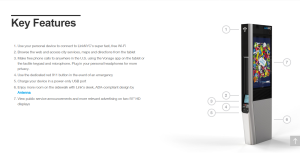Proposed rule change would change text governing installation of public pay phones in landmarked area to allow for installation of Public Design Commission-approved public communications structures with digital advertising. On March 3, 2016, the Landmarks Preservation Commission held a hearing on a proposed amendment to agency rules governing the installation phone booths. The proposed rule changes would update the agency rules pertaining to public pay phones. The updated rules responds to the de Blasio administration’s initiative to replace public pay phones with new public communications structures providing phone service and free Wi-Fi, with a tablet that accesses emergency services, and charging stations for cellphones and other electronic devices.
The program, called LinkNYC, is intended to be self-funded through advertising on the kiosks. The appearance planned kiosks have already been approved by the Public Design Commission and the franchise has been awarded to CityBridge, a consortium of telecommunications and technology firms.
In the request for proposals issued by the Department of Information Technology and Telecommunications on April 30, 2014, seeking a vendor to design, install and maintain the public communications structures. The RFP calls for the replacement of approximately 7,300 pay phones throughout the City with the structures, and asks that the design and placement must “minimize impacts on pedestrian circulation and the visual character of the streetscape.”
Commissioners voted to add the hearing to their calendar on March 22nd. The hearing was also duly advertised in the City Record on April 1, 2016, in accordance with the City Administrative Procedure Act.
Landmarks Counsel Mark Silberman presented the proposed rule amendments, and stated that under the initiative, all existing payphones would be replaced with kiosks by 2019.
Under the proposed changes, the public communication structures can be installed without seeking Landmarks approval as long as it is done under DoITT’s siting requirements. The kiosks would not be installed in stone sidewalks in historic districts or directly in front of individual landmarks. The kiosks including advertising will not be sited in residential zones.
Each kiosk will have up to two digital advertising panels, with images transitioning every 15 seconds. The slab-shaped structure will be clad in aluminum. Because LinkNYC is a Citywide initiative, the Public Design Commission holds binding authority overs the kiosks’ appearance. The kiosks will range in height from nine-and-half feet to a little over ten feet.
Testimony generally opposed the new kiosks, or asked Landmarks to amend the rule to mitigate the impact of the kiosks in designated areas. Sean Khorsandi of Landmark West decried the “ever-increasing assault of advertising” on City streets, and stated that the Wi-Fi service could instead be innocuously installed in existing street lamps. Khorsandi asserted that the project was driven more by advertising revenues than by the creation of a public good, in case of the “tail wagging the dog.” Judy Stanton, of the Brooklyn Heights Association, testified that kiosks constituted an “unnecessary and unwarranted commercial presence,” and asked that the kiosks be limited to commercially zoned intersections. The Society of the Architecture for the City’s Christabel Gough regretted the lack of Landmarks input and oversight of the kiosks, and stated that the Public Design Commission avoids taking into account issues of historic preservation.
Lo van der Valk, of Carnegie Hill Neighbors, lamented that the planning and design process did not include input from community boards, and suggested a number of way the kiosks could be modified in historic districts, including dimming the advertising displays, and interspersing commercial images with others relating to the neighborhood, the City, or to nature. Representatives of the Historic Districts Council and Friends of the Upper East Side also asked that the rules be further refined and that additional restrictions be placed on the kiosks.
Citybridge representative Jennifer Hensley said the removal of the 350 pay phones currently located in historic districts would enhance the City’s streetscape, and noted that new kiosks would have a smaller footprint than existing pay phones. In response to a commissioner question, Hensley stated that kiosks will be inspected two times per week to ensure that they are in working order. The Municipal Art Society’s Tara Kelly stated that the proposed rules were appropriate, closely following the rules previously governing pay phones, and providing a public utility of benefit to all New Yorkers.
Commissioners will respond to the proposed rule and make recommendations at future date, before voting on its adoption.
LPC: Proposed Citywide Rule, §2-21 (May 3, 2016).
By: Jesse Denno (Jesse is a full-time staff writer at the Center for NYC Law)



I wonder about the actual public service offered by the new digital kiosks. Will people actually plug in their phones and stand there in the street for a half hour or hour while they charge? Or will they plug in their phones and use them attached to the kiosk’s energy? Am I missing something here? Seems like a lot of design and trouble for only a few users. Has a real need been demonstrated for this “service”? It feels like yet another excuse to have advertising in our streets, which we don’t need more of. The most wonderful week in our city, in a perverse way, was the advertising silence right after 9-11! Enough said.